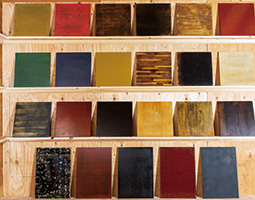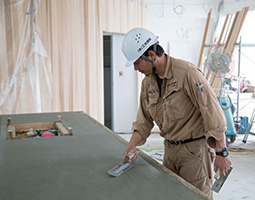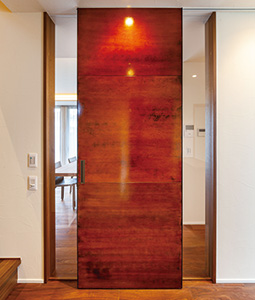May 2022
Technology to Coat Concrete with Japanese Lacquer

A concrete café counter coated in lacquer -

A hotel lobby renovated with walls coated with lacquer over non-combustible building materials

Sample building materials coated in lacquer 
A craftsmen smoothing a concrete surface for coating with lacquer 
A variety of lacquer-coated interior furnishings in the Heisei Corporation showroom 
Wall of a house fitted with calcium silicate board (a board made of non-combustible materials) coated in lacquer

Technology has been developed that makes it possible to coat concrete and other building materials with lacquer, adding new value to the traditional coating material.

Lacquer is a traditional Japanese paint made from sap harvested from the lacquer tree. This lacquer is widely used as a coating for familiar wooden items such as plates, bowls, chopsticks and cases to hold letters, and has long been popular among Japanese people.

The Heisei Corporation, which has its headquarters in Numazu City along the Pacific coast of Shizuoka Prefecture in the center of the main island of Honshu, has developed a new technology to coat concrete and other non-combustible materials with lacquer. The technology was patented in 2017. The surface of these materials is waterproof, antibacterial, and possesses the same texture, colors, and luster of lacquered wood, but with conventional concrete underneath the lacquer, the materials work well with modern construction methods and are being used more and more as modern building materials not only for personal residences but for hotels and cafés as well. Due to its deep shine and beauty, lacquer is highly praised both in Japan and abroad as a coating that uses natural materials (see here). However, when it is applied to strongly alkaline substrate surfaces such as concrete or plaster, a chemical reaction occurs, making stable fixation and best use of its attributes difficult. In addition, the use of new construction materials, which are inexpensive and easy to use and maintain, has spread, especially in modern times, and lacquer’s use in ordinary architecture for homes and public facilities has decreased drastically in modern-day Japan. Thanks to this new technology, however, it has become extremely easy to incorporate lacquer into a variety of buildings.

Aruga Tatsuki of Heisei Corporation led the development of the technology. He says, “I was surprised at the beautiful texture never before seen when we first coated concrete with lacquer as a practical internal experiment.” This first example of lacquered concrete was a surprise for Aruga, who was born into a family of lacquer craftsmen and had studied lacquer techniques and design. “I was fascinated by the unique texture and look of the cool, modern concrete texture beneath the traditional luster of lacquer. I was reminded again that lacquer is a coating that brings out the characteristics of a material to the fullest.”
But development of this new technology was challenging. A neutral to slightly acidic pH is needed for urushiol, a resin and primary component of lacquer, to set. Different from wood, lacquer doesn’t set completely and doesn’t stick well when coating alkaline concrete with lacquer. Soon the lacquer will peel off and the color may change. Aruga and others carried out research into fixing lacquer onto alkaline non-combustible materials and produced many prototypes. The key to solving the problem came from an old technology used to coat the surface of iron by baking it to prevent rust, something that is used in the process of creating Nanbu tekki (cast iron products made in Iwate Prefecture since the 17th century, see March 2012 edition of Highlighting JAPAN). This technique, which involves rubbing lacquer into heated iron kettles, makes use of the fact that lacquer sets at high temperatures. Aruga then thought of a method for adding heat to the surface of building materials. Through trial and error, he and his team established the technology to stabilize lacquer on highly alkaline materials like concrete by applying special treatments to the materials, and a patent was awarded for this technology.

Heisei Corporation has been praised for the design representations of lacquer from this technology and was awarded the GOOD DESIGN AWARD 2017 for its lacquer coating technique applied to non-combustible materials by the Japan Institute of Design Promotion (JDP).
Aruga is currently the supervisor (and chief) of Spatial Urushi Art, a lacquer (Urushi) project developed by Heisei Corporation, proposing and using lacquer in spaces (Spatial) with a variety of styles. For example, in a normal home, they were able to express a warm texture and transparency with a unique hint of orange by coating a plaster-covered wall at the entrance to the home with lacquer. They also worked on a hotel lobby with jet-black lacquer walls and indirect lighting to create a spatial presentation and a lacquered concrete café counter that offers both a sense of dignified solidity and softness. In such ways, this project is creating a variety of expressions through lacquer, and Heisei Corporation is considering expanding this use of lacquer overseas.

Lacquer coating finishing work requires a time-consuming and labor-intensive process, making it more expensive than the more commonly used paints. This is one of the reasons why, currently in Japan, use of lacquer is declining. In such a situation, technology to coat concrete and other non-combustible materials produces new value for this traditional coating material.

